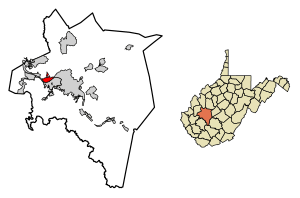Dunbar, West Virginia facts for kids
Quick facts for kids
City of Dunbar
|
||
|---|---|---|
|
||

Location of Dunbar in Kanawha County, West Virginia.
|
||
| Country | ||
| State | ||
| County | Kanawha | |
| Area | ||
| • Total | 2.81 sq mi (7.27 km2) | |
| • Land | 2.80 sq mi (7.26 km2) | |
| • Water | 0.00 sq mi (0.01 km2) | |
| Elevation | 594 ft (181 m) | |
| Population
(2020)
|
||
| • Total | 7,479 | |
| • Estimate
(2021)
|
7,330 | |
| • Density | 2,531.41/sq mi (977.26/km2) | |
| Time zone | UTC-5 (Eastern (EST)) | |
| • Summer (DST) | UTC-4 (EDT) | |
| ZIP code |
25064
|
|
| Area code(s) | 304 | |
| FIPS code | 54-22564 | |
| GNIS feature ID | 1538426 | |
Dunbar is a city in Kanawha County, West Virginia, United States. It is located along the Kanawha River. In 2020, about 7,479 people lived there.
Contents
A Look at Dunbar's Past
Dunbar became an official city on April 19, 1921. This happened through a special law passed by the West Virginia Legislature. The land where Dunbar now stands was first home to Native Americans. People have found 11 ancient mounds in the city's neighborhoods.
The land was once given to George Washington for his military service. Some say the city was named after Mary Dunbar, who inherited the land from Washington. Other stories suggest it was named for Dunbar Baines, a well-known banker in the area.
For a long time, Dunbar was mainly a farming community. But things started to change around 1912. That's when glass and bottling factories opened in the city. In 1916, the famous Gravely Plow was invented right here in Dunbar. This invention helped farmers a lot.
Dutch Hollow Wine Cellars
Dunbar is also home to the Dutch Hollow Wine Cellars. This special place was added to the National Register of Historic Places in 1970. It's famous for its unique walk-in wine cellars.
In the past, this area was known for its many vineyards. People grew grapes and used these cellars to store the wine they made. The cellars were likely built around 1860, when wine-making was very popular. The wine was then sent to nearby cities like Charleston and Cincinnati.
After the American Civil War, making wine became less profitable. The vineyards were eventually left empty. Also, wine from neighboring states like Virginia and Ohio became more popular. Today, the wine cellars are protected. Dunbar turned the area into a city park, so future generations can learn about its history.
Where is Dunbar Located?
Dunbar is located at 38°21′52″N 81°44′22″W / 38.36444°N 81.73944°W. It is easy to reach by car. Major roads like Interstate 64 and WV 25 serve the city.
The city covers a total area of about 2.81 square miles (7.27 square kilometers). Most of this area, about 2.80 square miles (7.26 square kilometers), is land. Only a tiny part, about 0.01 square miles (0.01 square kilometers), is water.
Who Lives in Dunbar?
| Historical population | |||
|---|---|---|---|
| Census | Pop. | %± | |
| 1930 | 4,189 | — | |
| 1940 | 5,266 | 25.7% | |
| 1950 | 8,032 | 52.5% | |
| 1960 | 11,006 | 37.0% | |
| 1970 | 9,151 | −16.9% | |
| 1980 | 9,285 | 1.5% | |
| 1990 | 8,697 | −6.3% | |
| 2000 | 8,154 | −6.2% | |
| 2010 | 7,907 | −3.0% | |
| 2020 | 7,479 | −5.4% | |
| 2021 (est.) | 7,330 | −7.3% | |
| U.S. Decennial Census | |||
Population in 2010
According to the 2010 census, there were 7,907 people living in Dunbar. There were 3,795 homes in the city. The city had about 2,824 people per square mile (1,090 people per square kilometer).
Most people in Dunbar were White, making up 82.7% of the population. About 12.2% were African American. There were also smaller groups of Asian people (1.7%) and Native American people (0.2%). About 2.7% of people were of two or more races. People of Hispanic or Latino background made up 1.0% of the population.
The average age of people in Dunbar was 43.2 years old. About 18.4% of residents were under 18 years old. About 20.1% were 65 years old or older. The city had more females (54.3%) than males (45.7%).
See also
 In Spanish: Dunbar (Virginia Occidental) para niños
In Spanish: Dunbar (Virginia Occidental) para niños



